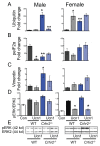Corticotropin-releasing factor receptor 2 mediates sex-specific cellular stress responses
- PMID: 23835907
- PMCID: PMC3745594
- DOI: 10.2119/molmed.2013.00036
Corticotropin-releasing factor receptor 2 mediates sex-specific cellular stress responses
Abstract
Although females suffer twice as much as males from stress-related disorders, sex-specific participating and pathogenic cellular stress mechanisms remain uncharacterized. Using corticotropin-releasing factor receptor 2-deficient (Crhr2-/-) and wild-type (WT) mice, we show that CRF receptor type 2 (CRF2) and its high-affinity ligand, urocortin 1 (Ucn1), are key mediators of the endoplasmic reticulum (ER) stress response in a murine model of acute pancreatic inflammation. Ucn1 was expressed de novo in acinar cells of male, but not female WT mice during acute inflammation. Upon insult, acinar Ucn1 induction was markedly attenuated in male but not female Crhr2-/- mice. Crhr2-/- mice of both sexes show exacerbated acinar cell inflammation and necrosis. Electron microscopy showed mild ER damage in WT male mice and markedly distorted ER structure in Crhr2-/- male mice during pancreatitis. WT and Crhr2-/- female mice showed similarly distorted ER ultrastructure that was less severe than distortion seen in Crhr2-/- male mice. Damage in ER structure was accompanied by increased ubiquitination, peIF2, and mistargeted localization of vimentin in WT mice that was further exacerbated in Crhr2-/- mice of both sexes during pancreatitis. Exogenous Ucn1 rescued many aspects of histological damage and cellular stress response, including restoration of ER structure in male WT and Crhr2-/- mice, but not in females. Instead, females often showed increased damage. Thus, specific cellular pathways involved in coping and resolution seem to be distinct to each sex. Our results demonstrate the importance of identifying sex-specific pathogenic mechanisms and their value in designing effective therapeutics.
Figures







Similar articles
-
Effects of stress-related peptides on chloride secretion in the mouse proximal colon.Neurogastroenterol Motil. 2021 Apr;33(4):e14021. doi: 10.1111/nmo.14021. Epub 2020 Oct 28. Neurogastroenterol Motil. 2021. PMID: 33118282
-
Pharmacological Evaluation of a Pegylated Urocortin-1 Peptide in Experimental Autoimmune Disease Models.J Pharmacol Exp Ther. 2022 Sep;382(3):287-298. doi: 10.1124/jpet.122.001151. Epub 2022 Jun 10. J Pharmacol Exp Ther. 2022. PMID: 35688476
-
Sexually dimorphic metabolic responses mediated by CRF2 receptor during nutritional stress in mice.Biol Sex Differ. 2018 Nov 6;9(1):49. doi: 10.1186/s13293-018-0208-4. Biol Sex Differ. 2018. PMID: 30400826 Free PMC article.
-
Corticotropin-Releasing Hormone Family and Their Receptors in the Cardiovascular System.Circ J. 2019 Jan 25;83(2):261-266. doi: 10.1253/circj.CJ-18-0428. Epub 2018 Dec 22. Circ J. 2019. PMID: 30584229 Review.
-
Corticotropin-releasing factor receptors and urocortins, links between the brain and the heart.Eur J Pharmacol. 2010 Apr 25;632(1-3):1-6. doi: 10.1016/j.ejphar.2010.01.027. Epub 2010 Feb 2. Eur J Pharmacol. 2010. PMID: 20132811 Review.
Cited by
-
Multi-facets of Corticotropin-releasing Factor in Modulating Inflammation and Angiogenesis.J Neurogastroenterol Motil. 2015 Jan 1;21(1):25-32. doi: 10.5056/jnm14076. J Neurogastroenterol Motil. 2015. PMID: 25540945 Free PMC article.
-
Protective effects of urocortin 2 against caerulein-induced acute pancreatitis.PLoS One. 2019 May 17;14(5):e0217065. doi: 10.1371/journal.pone.0217065. eCollection 2019. PLoS One. 2019. PMID: 31100090 Free PMC article.
-
Corticotropin-Releasing Factor Family: A Stress Hormone-Receptor System's Emerging Role in Mediating Sex-Specific Signaling.Cells. 2020 Mar 31;9(4):839. doi: 10.3390/cells9040839. Cells. 2020. PMID: 32244319 Free PMC article. Review.
-
Considering Sex as a Biological Variable in Basic and Clinical Studies: An Endocrine Society Scientific Statement.Endocr Rev. 2021 May 25;42(3):219-258. doi: 10.1210/endrev/bnaa034. Endocr Rev. 2021. PMID: 33704446 Free PMC article.
-
Urocortin 3 overexpression reduces ER stress and heat shock response in 3T3-L1 adipocytes.Sci Rep. 2021 Aug 2;11(1):15666. doi: 10.1038/s41598-021-95175-4. Sci Rep. 2021. PMID: 34341463 Free PMC article.
References
-
- Muglia L, Jacobson L, Dikkes P, Majzoub JA. Corticotropin-releasing hormone deficiency reveals major fetal but not adult glucocorticoid need. Nature. 1995;373:427–32. - PubMed
-
- Slominski A, et al. Cutaneous expression of corticotropin-releasing hormone (CRH), urocortin, and CRH receptors. FASEB J. 2001;15:1678–93. - PubMed
-
- Chen A, Blount A, Vaughan J, Brar B, Vale W. Urocortin II gene is highly expressed in mouse skin and skeletal muscle tissues: localization, basal expression in corticotropin-releasing factor receptor (CRFR) 1- and CRFR2-null mice, and regulation by glucocorticoids. Endocrinology. 2004;145:2445–57. - PubMed
-
- Baigent SM. Peripheral corticotropin-releasing hormone and urocortin in the control of the immune response. Peptides. 2001;22:809–20. - PubMed
-
- Wu Y, Xu Y, Zhou H, Tao J, Li S. Expression of urocortin in rat lung and its effect on pulmonary vascular permeability. J Endocrinol. 2006;189:167–78. - PubMed
Publication types
MeSH terms
Substances
Grants and funding
LinkOut - more resources
Full Text Sources
Other Literature Sources
Medical
Molecular Biology Databases

